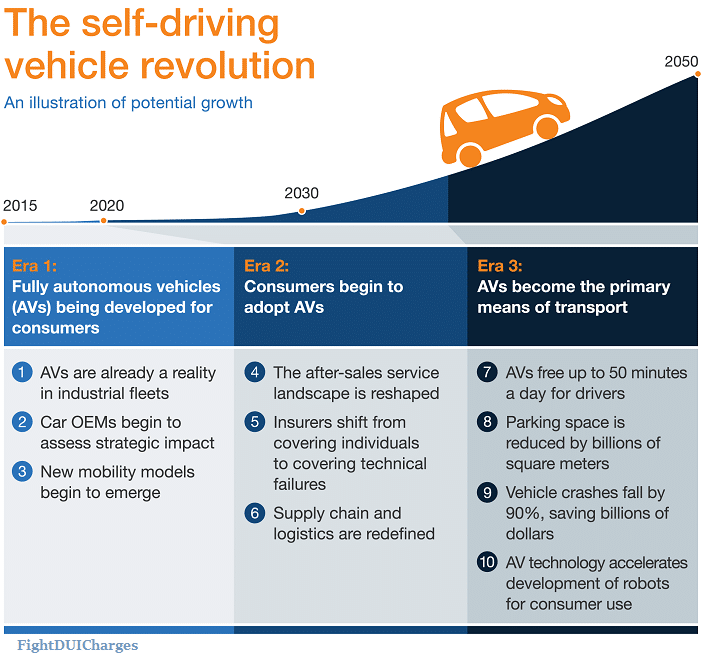In 2024, top automakers are working on new technologies to help combat drunk driving with:
- Driver-monitoring systems: These systems use cameras or other sensors to monitor a driver’s head and eyes. They can also ensure that drivers are paying attention while using advanced driver-assistance features.
- Alcohol detection systems: These systems use sensors to determine if a driver is drunk and can prevent the vehicle from moving. The National Transportation Safety Board (NTSB) recommends that all new vehicles in the U.S. have blood alcohol monitoring systems.
- Breath-based alcohol detection: Prototype designs for this technology are expected to be completed in 2024.
- Touch-based prototypes: These prototypes are expected in 2025.
- Ignition interlock devices: These devices are typically used by those with existing DUI convictions. They force offenders to provide a sober breath sample before operating their vehicles.
The Rise of Advanced Driver-Assistance Systems (ADAS)
Modern cars are increasingly equipped with ADAS features designed to assist drivers and enhance safety. These features include:
- Lane departure warning (LDW): Alerts drivers when they unintentionally veer out of their lane.
- Automatic emergency braking (AEB): Applies brakes automatically to prevent or mitigate frontal collisions.
- Blind spot monitoring (BSM): Warns drivers of vehicles in their blind spots.
These technologies are already making a significant impact. Studies by the National Highway Traffic Safety Administration (NHTSA) show that LDW can reduce lane departure crashes by 86% and AEB can lower forward collisions by up to 50%.
Towards Self-Driving Cars: The Future of Transportation?
The most significant development comes from the ongoing advancements in autonomous vehicles. Self-driving cars, once a futuristic concept, are now being rigorously tested by leading automakers like Tesla, Ford, and General Motors.
These vehicles utilize a combination of cameras, radar, and lidar sensors to navigate roads, adhering to traffic laws and eliminating the possibility of human error due to impairment.
While fully autonomous vehicles are still in the developmental stages, their potential to revolutionize transportation and drastically reduce DUIs is undeniable.

Tesla CEO Elon Musk helps bring automotive technology revolutionaries like Tesla, one step closer to changing the way we drive forever.
The evolution of our driving experience with autonomous cars will bring about a safer experience for everyone sharing the road. Very soon this technology will be integrated into all of our daily lives just like a smartphone has become.
Case Scenario: How ADAS Can Help Prevent New DUIs
Imagine a scenario where Emma, after attending a social gathering, considers driving home despite consuming alcohol.
However, her car’s LDW system detects her swerving and triggers an audio-visual warning, urging her to pull over. Additionally, the AEB system is ready to intervene if Emma fails to maintain control, potentially preventing an accident and a DUI charge.
This scenario exemplifies how ADAS features can act as a safeguard against impaired driving, offering drivers a crucial second chance to make the right decision.
Avoidable accidents resulting from errors in human judgement such as drunk, reckless, and distracted driving can be eliminated from part of the traffic risk we have been forced to accept as a harsh reality in everyday driving.
The Road Ahead: Legal and Ethical Considerations
While the future of transportation appears increasingly autonomous, it’s crucial to acknowledge the ongoing legal and ethical considerations surrounding self-driving cars.
Questions regarding liability in case of accidents involving autonomous vehicles need to be addressed through comprehensive legislation. Additionally, ethical concerns surrounding data privacy and potential biases in the algorithms controlling these vehicles need careful consideration.
How Expertise of DUI Lawyers Helps With ADAS Impact on Future DUI Cases
As Board Certified DUI lawyers, we our committed to staying informed about the evolving landscape of automotive technology and its potential impact on DUI cases.
While ADAS and self-driving cars hold immense promise for preventing DUIs, it’s important to remember that these technologies are still under development. If you are facing DUI charges, we encourage you to seek legal counsel immediately.
An experienced DUI lawyer can help you navigate the legal complexities of your case and fight for the best possible outcome.
Key Takeaways
Soon there will be a clear winner in the race to build the fully autonomous car that is affordable for the masses, and succeeds at transforming the automotive market forever going forward into the future.
However the ultimate victory will be for the everyday people sharing the world’s roadways, when preventable accidents such as those caused by DUI or texting and driving become a thing of the past.
Fortunately, this technology means significantly less people will find themselves having to explore ways how to get out of DUI charges when their car is driven by computer and not an impaired driver.

Taryn J. White is a legal research specialist and DUI law news reporter. Her current accomplishments include helping those facing any driving under the influence arrest charges, get free online assistance in learning how to fight a DUI case for the best possible outcome.




I need to install iid on tesla model 3 2020
Please let me know where i can find the installer